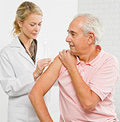 Europe has a lot going for it. Health services are, for the most part, excellent and easily accessible. Immunisation is free and childhood vaccine schedules are well established.
Europe has a lot going for it. Health services are, for the most part, excellent and easily accessible. Immunisation is free and childhood vaccine schedules are well established.
The trouble is that most Europeans think vaccination begins and ends in childhood. The consequences of this are very real.
Take Europe’s ongoing measles outbreak, for example. There have been 4,000 cases in the European Union and thousands more in neighbouring countries. 70% of the EU cases have been in German and Italy – two of the most developed nations in the world.
Many children have caught the virus and, tragically, a toddler in Berlin died from the disease. But there are also many outbreaks in adolescents and young adults – most of whom missed out on crucial vaccines when MMR uptake dropped in the late 1990s.
Catch-up for teens
These kinds of legacy issues are making it very difficult for Europe to beat measles and rubella even though MMR immunisation rates are high. Even in the UK, the epicentre of the MMR scare, vaccination rates are back to where they were before the panic.
Catch-up programmes have been rolled out in several countries but there are still pockets of susceptibility in the teenage and young adult population.
With Rubella, the picture is similar but for a different reason. Of the 4,394 rubella cases reported to the European Centre for Disease Prevention and Control (ECDC) in the 12 months leading up to March 2015, almost all of them – 96% – were in Poland.
Most cases were in children but adolescents and adults were seriously affected. What is striking is the number of young men affected. In the 15-19 year age group the male-female ratio is almost 6:1; while in the 20-24 year group the ratio is 5:1.
Why? Between 1989 and 2004, only adolescent girls in Poland were vaccinated against rubella. The thinking behind this practice (which was common in several European countries) was that rates of congenital rubella syndrome (CRS) could be curbed by vaccinating young women.
This has a certain logic but left young men unprotected, meaning the virus continued to spread in the community. Since 2004, a universal two-dose MMR vaccination programme for boys and girls has been in place in Poland.
Diverse vaccine schedules
One of the more challenging aspects of immunisation services in Europe is their diversity. Programs are funded and delivered at national level. The schedule can differ from one country to the next and, for Spain and Italy, each region has a degree of autonomy in selecting which shots to offer and when.
This is perhaps best illustrated by influenza vaccination rates. Europe does not have a universal recommendation for flu vaccine. Some countries focus on older people; some concentrate on older people and those with chronic conditions; a number now prioritise pregnant women; and one – the UK – has started offering the flu vaccine to all children.
While European Union (EU) health ministers have committed to a target of 75% flu vaccine coverage among high-risk groups, only the Netherlands and the UK have hit this target. Some countries are a long way behind. In general, central and eastern European countries have some of the best childhood immunisation rates in the world but are years away from hitting their 75% target.
Reason to hope
Immunisation rates for pneumococcal disease, HPV, shingles and flu are also patchy. On a continent with a rapidly ageing population, it is imperative to keep people healthy and active for as long as possible.
European health ministers agreed a statement late last year in which they pledged to “consider immunisation beyond infancy and early childhood by creating vaccination programmes with a life-long approach”. This did not make many headlines but could have an important impact over time.
What can you do? Good question, kind of you to ask! Europe lacks civil society vaccine advocacy groups of the kind seen in the US. We do not have Nurses Who Vaccinate, Parents For Vaccines, MomsWhoVax, Voices for Vaccines, Shot by Shot or an Immunisation Action Coalition.
Share your experience and expertise of communication and advocacy with your European counterparts. Tell them what works. Urge them to take ownership and to take action. Empower them. Academics, health professionals, parents, patient groups, active ageing campaigners – we all need to step up to find shared solutions.
This post was originally published by George Washington University as part of a series of guest articles to mark National Immunisation Month in the US. Read more from the GW public health blog
Become a Vaccines Today Supporter Email: e�ditor@vacc�inestoday.eu�




